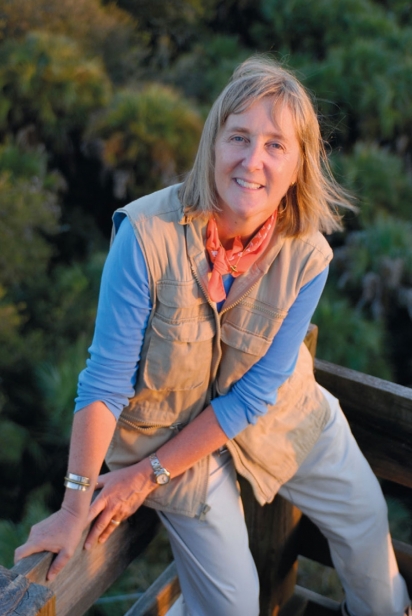High Hopes
Dr. Margaret Lowman is among the most impressive women I’ve ever met.
Her determination has earned her the titles of biologist, educator, mother, ecologist, author, fundraiser, conservationist, public speaker, and National Geographic explorer. She holds an undergrad in biology, a master’s in ecology, and a PhD in botany.
Lowman has decades of experience as a published field scientist who's worked in 46 countries across all seven continents. She’s launched nature research centers and run nonprofit organizations. She even coined a new title, arbornaut, to describe people like herself who study trees up among the canopies in what she refers to as the eighth continent of the world.
“Trees house everything,” says Lowman. “They’re kind of Mother Earth for the whole world in the sense that they house biodiversity, store carbon, and produce energy for all of us.”
“Canopy Meg,” nickname bestowed by oceanographer Robert Ballard, is brilliant and inspirational and although her heart lives high in the trees, she is amazingly down to earth.
But what wows me the most about this original arbornaut is her devotion to the conservation of forest canopy ecology despite the challenges she’s experienced to get to where she is today.
A shy, quiet little girl, Lowman found her comfort and calling among the local flora and fauna in her hometown of Elmira, New York. She and her girlfriends would build stick forts and rescue birds that fell from trees. Her mom would wake up early to take her birding, and at the end of the day Lowman’s freshly collected flowers would end up cataloged and pressed in phone books under her bed.
“In rural upstate New York, we didn’t have easy access to museums, scientists as role models, or other resources to nourish a child’s love of natural science,” she writes in her memoir The Arbornaut, a highly recommended and enlightening read. “All we had was outdoor play. But that simple pleasure transformed a small-town kid into a young naturalist.”
Lowman’s continued interest in nature initially led her to believe she’d never fit in. Time at a nature-based summer camp as a preteen proved otherwise when her camp project on the local moss was so impressive to camp staff that they asked her to return the following year as a camp counselor, not a camper. Assigned the topic of dendrology—the study of trees—the knowledge sparked a focused interest, and the experience transformed Lowman’s introverted personality into one of an “enthusiastic educator.” Three decades after her first camp experience, she would return to help build a tree canopy walk so campers could explore nature from her favorite angle: up among the trees.
Lowman encountered constant sexism throughout her education and career as one of few accomplished women in a male-dominated industry. Still, she never gave up or shied away from advanced education or research in remote forests worldwide. Lowman has participated in adventures rivaling Bear Grylls—all in the name of trees. When equipment to access tree canopies for her studies did not yet exist, she used her ingenuity to create it using a handmade slingshot and spelunking gear. Lowman accepted being the lone woman camping in the jungle with men before such a feat was socially acceptable. She slept in hammocks over pits of snakes and elegantly endured leech and bug infestations.
Lowman has trekked through it all. And although her intention was never to break glass ceilings, her resilience has—no doubt—forged a broader path for girls in field-study science and conservation leadership.
Still, after all, she has accomplished as a woman and a scientist, her biggest claim to fame, she says, is what she found up in the canopy.
“One of the biggest discoveries was to find out that half of the species in the world live at the top of a tree,” says Lowman. “Not on the forest floor, and not in the grass, and certainly not in the croplands or even along the ocean shore. That means there are millions and millions of things up there, most of which we haven’t discovered, yet.”
More from Meg…
On how she and Elizabeth Moore joined forces:
“Somehow everybody in the community recognized that we were kindred spirits when it came to things like trees and conservation … and it was true that when we met each other, we knew that we probably had been separated at birth.”
On the need for girl power in science and conservation:
“More women need to help other women. It wasn’t really the case in my day because there weren’t other women to help. I think, today, there’s a cadre of women entrepreneurs, innovators, and leaders. We all have to reach out and help every single girl that comes in front of us.”
On getting screen-bound kids outside:
“Make it a game. Treasure hunts are great. Say you have to find 10 acorns and nine leaves, two beetles, and one snakeskin. And occasionally a night walk with a headlamp or a flashlight is so cool. Trying to think like a kid is probably your best bet.”
Lowman earned her first degree at Williams College in Massachusetts before taking on higher education and fellowships in Scotland and Australia, where she co-managed a five-generation sheep and cattle farm. A desire to escape Australia’s gender prejudice with her two young sons brought her back to the States. In the early 1990s, she accepted a leadership position as CEO at Marie Selby Botanical Gardens. Lowman became a tenured New College professor, which kept her in Sarasota for another eight years before she went on to do great things in North Carolina and California. She returned to Sarasota in 2019.
While the first half of Canopy Meg’s life was dedicated to field studies, the Sarasota-based arbornaut plans to spend the second half working to conserve those mature forest canopies she’s spent thousands of hours dangling among. And from what she has witnessed and what she shares, the trees need all the help they can get.
“In my lifetime, half the world’s trees have been cut down,” Lowman tells me. “So, we’re really doing a terrible stewardship job. It doesn’t add up to plant a new tree when you cut down a big tree. A koala can’t live in a seedling. It’s probably 100 or 200 years before a tree can house all the creatures that lived in a big tree if you remove it.”
Lowman believes our best chance at saving these ancient trees is to ensure their protection.
“As the planet gets warmer, trees are one of the immediate solutions to climate change,” she says.
Lowman works tirelessly to educate people—young and old—on the vital importance of ancient forest trees and to raise money to build canopy walks around the world. In 1999, she co-founded the TREE Foundation to promote Tree Research, Education, and Exploration and to expose underserved children to the natural world. The TREE Foundation was responsible for the first canopy walk in North America, which proudly lives among the trees of Myakka River State Park and remains a model for future canopy walks worldwide. Lowman is now the foundation’s executive director, working alongside its president, Elizabeth Moore, a well-known conservationist, and philanthropist who joined the board in 2020.
Meg created Mission Green in 2020 as a project under the TREE Foundation to fundraise for more canopies to fight global deforestation in low-income and third-world countries and protect the biodiversity throughout canopy forests.
“Look at Myakka with a yearly regional revenue of around $30 million and half a million visitors a year. If we could even come halfway to that in some of these indigenous countries where people have no income from eco-tourism, then we can turn it around; we can save the trees,” she says. “We can also employ women and provide amazing education and research experience platforms for students.”
If Mission Green meets its goal, it will fund the construction of canopy walkways in the world’s 10 most biodiverse hot spots, including Ethiopia and Madagascar, where less than 4 percent of forests remain.
“The 10 most important forests in the world deserve to get Myakka walkways that we have to fund and build because their countries are too poor to afford them,” she says. “Then they can own them, maintain them, run eco-tourism operations, and have their own students make cool discoveries and become famous scientists in their own right.”
Lowman admits fundraising for nature conservation is surprisingly tricky, even in wealthy parts of the world. But in true Canopy Meg fashion, she doesn’t dwell on it. Instead, she remains positive and as determined as ever.
“I’m excited about two things. One is our success with these walkways,” she says. Four are finished: in Malaysia and in the Amazon and here in Florida, and now the latest, in the California redwoods. And we’re hoping for Madagascar. And, then, I’m excited about young people.”
Through Mission Green, Lowman also fosters connections and steward-ship in school-aged children, whom she believes can make the best citizen scientists and have the potential to significantly impact conservation and future discoveries.
“I think we have to really give our kids hope,” she says.
“As a scientist and a parent, I want to take a stand to ensure that the next generation will inherit a healthy world in which to live,” she states on the Mission Green website.
Canopy Meg, on behalf of the trees and women everywhere, THANK YOU for continuing to take a stand!
To find out more about Canopy Meg’s accomplishments and current projects visit canopymeg.com/.
Visit https://treefoundation.org/ to learn more and consider a donation to help save the trees.






